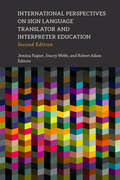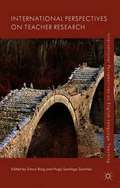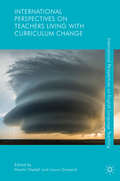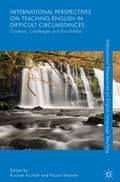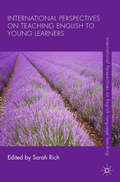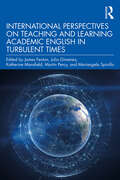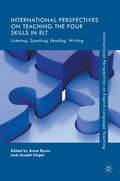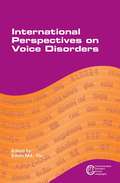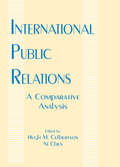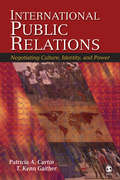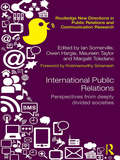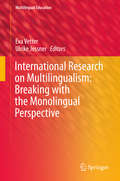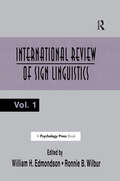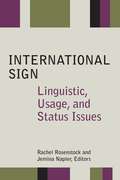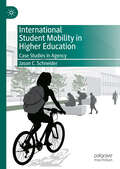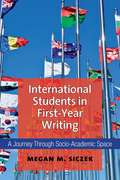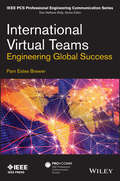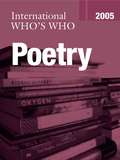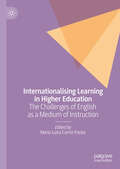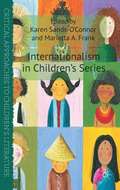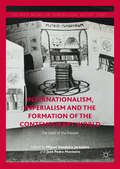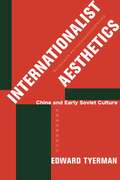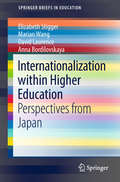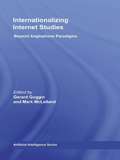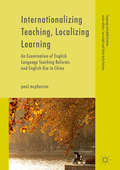- Table View
- List View
International Perspectives on Sign Language Translator and Interpreter Education (Interpreter Education #14)
by Jemina Napier; Stacey Webb; Robert AdamThe field of sign language translator and interpreter (SLTI) education gets a global treatment in this new volume helmed by editors Jemina Napier, Stacey Webb, and Robert Adam. This second edition updates the information from the 2009 volume and adds new contributions that expand the scope of the work to include additional countries and topic areas. SLTI scholars and educators will benefit from these international perspectives and gain an improved understanding of this rapidly evolving discipline. Each chapter, authored collaboratively by deaf and hearing educators, surveys general interpreter education and training, examines the status of the profession for both deaf and hearing practitioners, and addresses specific challenges faced within the different national frameworks. Contributors also discuss ongoing and future trends, including the impact of the Covid-19 pandemic on educational practices. This volume disseminates extensive knowledge on sign language translator and interpreter education, covering established programs as well as ad hoc training, and highlighting effective teaching pedagogies and structured classroom strategies. Contributors emphasize a holistic approach to the field, integrating SLTI education, the current profession, future practitioners, and deaf communities. Although the state of the field varies widely around the world depending on the national context, this volume reveals a shared goal of advancing professional standards and improving the provision of service to deaf people worldwide.
International Perspectives on Teacher Research
by Simon BorgTeacher research is recognized, in ELT and education more generally, as a powerful transformative strategy for teacher development and school improvement. This volume provides original insights into this issue by focusing on the processes involved in becoming and being a teacher researcher.
International Perspectives on Teachers Living with Curriculum Change
by Martin Wedell Laura Grassick"This book gives a voice to English language teachers faced with the challenges posed by English language curriculum change. As a core component of national state system curricula in virtually every country in the world, there has nevertheless been little research exploring how the millions of English teachers worldwide navigate the challenges posed by such curriculum changes. This volume includes eleven stories from teachers based across every continent, providing a global glimpse of how national English curriculum change projects have been experienced by classroom teachers who are commonly (if erroneously) viewed as mostly responsible for its implementation success or failure. The final chapter synthesises these experiences and suggests wider implications for the development of curriculum change planning processes, and how they might better support teachers' attempts to achieve curriculum goals. Edited and authored by leading experts in the field, this ground-breaking collection will be of interest to students and scholars of English language teaching, teacher education, curriculum change and education policy. "
International Perspectives on Teaching English in Difficult Circumstances: Contexts, Challenges and Possibilities (International Perspectives on English Language Teaching)
by Kuchah Kuchah Fauzia ShamimThis book offers a holistic practitioner and research-based perspective on English Language Teaching and teacher education in difficult circumstances. In addition to extending the current conceptualization of ‘difficult circumstances’ in ELT to include the broader policy issues that may affect ELT in low-to-mid income countries, the book focuses on the challenges faced by practitioners and learners in contexts of confinement, conflict and special education. The chapters in this collection examine the challenges and problems that emerge from the complex current ELT environment, and present examples of contextualized inquiry-based strategies and interventions to address these challenges. Underlining the need to extend the boundaries of the discipline of ELT to include teaching-learning in less privileged contexts, this wide-ranging volume will appeal to students, scholars and practitioners of English Language Teaching.
International Perspectives on Teaching English to Young Learners
by Sarah RichThis volume comprises 11 research-led accounts from Teaching English to Young Learner (TEYL) educators working in a range of diverse settings worldwide. The innovative practical and theoretical perspectives offer some important insights into effective TEYL pedagogy for the 21st century.
International Perspectives on Teaching and Learning Academic English in Turbulent Times
by Katherine Mansfield James Fenton Julio Gimenez Mariangela Spinillo Martin PercyThis volume shares proven strategies for Academic English teaching, research, and development in challenging circumstances. Through original first-hand experiences from around the world, the collection reveals how educators in higher education have responded to the specific needs and challenges of teaching second language learners in turbulent times, as seen during the COVID-19 pandemic. Organised thematically, the book covers rapid responses to crises, adapting to teaching online, collaborations and online learning communities, and assessment practices. The volume provides original insights and practical suggestions for a range of practices across English for Academic and Specific Purposes that can address new and unfamiliar circumstances, both now and in future challenging times. The collection includes a wealth of effective strategies, varied research methodologies, and resources for practice making it an invaluable reference for practitioners, students, and researchers in the field of academic English, ESL/EFL, and online language instruction.
International Perspectives on Teaching the Four Skills in ELT
by Anne Burns Joseph SiegelThis book offers a range of perspectives and insights from around the world on the teaching and learning of listening, speaking, reading and writing. It brings together contributors from across six continents, who analyse a wide range of teaching and learning contexts, including primary, secondary, tertiary, private, and adult ESL/EFL classes. In doing so, they provide locally relevant accounts that nonetheless resonate with other contexts and wider concerns. This informative and practical edited collection will appeal to students and scholars who are interested in the four building blocks of language learning, as well as language education and teacher education.
International Perspectives on Voice Disorders
by Edwin M-L. YiuThis book provides a state-of-the-art account of voice research and issues in clinical voice practice. The contributors are all voice experts and bring a range of international perspectives to the volume, which includes chapters focusing on Australia, Belgium, Brazil, China, Hong Kong, Israel, Japan, the UK and the USA. This is a pioneering work that brings together previously unpublished cutting-edge research and evaluations of clinical practice.
International Public Relations: A Comparative Analysis (Routledge Communication Series)
by Hugh M. Culbertson Ni ChenAs a formal occupation, public relations grew primarily in the United States through much of the twentieth century. In recent years, however, it has spread rapidly throughout the world. Broad outlines on how public relations practices differ from country to country have only recently begun to take shape in scholarly writing about the field. The existing literature on international public relations tends to focus on how those working for western organizations --particularly multi-national corporations--can best practice abroad. Although useful, such writings tend to focus on adaptation of western approaches, not on development of new ones designed specifically for varied sociocultural settings around the world. The editors have produced this book for a number of reasons. There has been tremendous growth in the teaching of public relations around the world--enhancing practice in many countries outside North America. There has also been rapid growth in the number of professors who demand theoretical perspectives which might facilitate a unified comparative analysis across countries and regions. Only a few U.S. universities--six documented in this book--now teach courses formerly called "International Public Relations." However, many professors are going abroad to teach and do research. This suggests increased interest in and a need for courses dealing with international public relations. Furthermore, there is a dearth of literature dealing in depth with international PR, an important component of international communication. This appears to be the first book-length comparative analysis of public relations as practiced in various countries and regions around the world. Although existing books on international PR focus largely on ways in which western practitioners, employers, and clients can operate effectively in other countries, this volume views public relations in each country or region covered from the perspective of practitioners in that country. It contains six chapters designed to provide a theoretical anchor for the 14 country and region analyses. Given the intense interest in public relations education as a factor in professional enhancement, it also discusses issues and practices relating to education.
International Public Relations: Negotiating Culture, Identity, and Power
by Patricia A. Curtin Dr T. Kenn GaitherInternational Public Relations: Negotiating Culture, Identity, and Power offers the first critical-cultural approach to international public relations theory and practice. Authors Patricia A. Curtin and T. Kenn Gaither introduce students to a cultural-economic model and accompanying practice matrix that explain public relations techniques and practices in a variety of regulatory, political, and cultural climates. offers the first critical-cultural approach to international public relations theory and practice. Authors Patricia A. Curtin and T. Kenn Gaither introduce students to a cultural-economic model and accompanying practice matrix that explain public relations techniques and practices in a variety of regulatory, political, and cultural climates.
International Public Relations: Perspectives from deeply divided societies (Routledge New Directions in PR & Communication Research)
by Ian Somerville, Owen Hargie, Maureen Taylor and Margalit ToledanoInternational Public Relations: Perspectives from deeply divided societies is positioned at the intersection of public relations (PR) practice with socio-political environments in divided, conflict and post-conflict societies. While most studies of PR focus on the activity as it is practiced within stable democratic societies, this book explores perspectives from contexts that have tended to be marginalized or uncharted. Presenting research from a diverse range of societies still deeply divided along racial, ethnic, religious or linguistic lines, this collection engages with a variety of questions including how PR practice in these societies may contribute to our understanding of PR theory building. Importantly, it highlights the role of communication strategies for actors that still deploy political violence to achieve their goals, as well as those that use it in building peace, resolving conflict, and assisting in the development of civil society. Featuring a uniquely wide range of original empirical research, including studies from Israel/Palestine, Mozambique, Northern Ireland, former Yugoslavia, former Czechoslovakia, Spain, Malaysia and Turkey, this groundbreaking book will be of interest not only to scholars of public relations, but also political communication, international relations, and peace and conflict studies. With a Foreword by Krishnamurthy Sriramesh, Editor of The Global Public Relations Handbook
International Research on Multilingualism: Breaking with the Monolingual Perspective (Multilingual Education #35)
by Eva Vetter Ulrike JessnerThis volume contributes to a better understanding of both psycho- and sociolinguistic levels of multilingualism and their interplay in development and use. The chapters stem from an international group of specialists in multilingualism with chapters from Austria, Canada, Germany, Hungary, Israel, Italy, Slovakia, South Africa, Spain and the United States. The chapters provide an update on research on third language acquisition and multilingualism, and pay particular attention to new research concepts and the exploration of contact phenomena such as transfer and language learning strategies in diverse language contact scenarios. Concepts covered include dominant language constellations, mother tongue, germination factors and communicative competence in national contexts. Multilingual use as described and applied in the volume aims at demonstrating and identifying current and future challenges for research on third language acquisition and multilingualism. The third languages in focus include widely and less widely used official, minority and migrant languages in instructed and/or natural contexts, including Albanian, Arabic, Basque, English, French, German, Hungarian, Italian, Romanian, Spanish, Punjabi, Russian, Turkish, and Vietnamese, thereby mapping a high variety of language constellations.
International Review of Sign Linguistics: Volume 1
by William H. Edmondson Ronnie B. WilburThe International Review of Sign Linguistics -- which replaces the International Journal of Sign Linguistics -- is planned as an annual series publishing the most up-to-date scholarly work in all aspects of sign language linguistics. There is no other comparable publication. The international community of sign linguists needs an authoritative outlet for its research findings. IRSL provides this forum for sign linguists, and for those mainstream linguists increasingly interested in sign languages, by filling the void in linguistic analysis of sign language -- as opposed to other concerns, such as deaf education, teaching sign languages, training interpreters, etc. -- and by pulling together in one place linguistic dialogue on sign language structure. It provides a scholarly focus for all linguists who need to remain current with developments in sign linguistics. For the growing international community, IRSL provides a focus for developments within the field and for advancement of the field in scattered research communities. This review contains seven articles covering a wide range of linguistic areas, signed languages, and theoretical perspectives. Papers deal with the lexicon, morphology, phonology, syntax, pragmatics, prosody, metalinguistic issues, and socio-historical change. Five signed languages are represented including American, German, Australian, French, and Israeli.
International Sign: Linguistic, Usage, and Status Issues
by Jemina Napier Rachel RosenstockInternational Sign (IS) is widely used among deaf people and interpreters at international events, but what exactly is it, what are its linguistic features, where does its lexicon come from, and how is it used at interpreted events? This groundbreaking collection is the first volume to provide answers to these questions. Editors Rachel Rosenstock and Jemina Napier have assembled an international group of renowned linguists and interpreters to examine various aspects of International Sign. Their contributions are divided into three parts: International Sign as a Linguistic System; International Sign in Action—Interpreting, Translation, and Teaching; and International Sign Policy and Language Planning. The chapters cover a range of topics, including the morphosyntactic and discursive structures of interpreted IS, the interplay between conventional linguistic elements and nonconventional gestural elements in IS discourse, how deaf signers who use different signed languages establish communication, Deaf/hearing IS interpreting teams and how they sign depicting verbs, how best to teach foundation-level IS skills, strategies used by IS interpreters when interpreting from IS into English, and explorations of the best ways to prepare interpreters for international events. The work of the editors and contributors in this volume makes International Sign the most comprehensive, research-based analysis of a young but growing field in linguistics and interpretation.
International Student Mobility in Higher Education: Case Studies in Agency
by Jason C. SchneiderThis book offers an in-depth look at the experiences of international students as they pursued undergraduate degrees in the US. Drawing on recurring interviews with the students and other qualitative data collected over four years, the book investigates how the students’ academic development intersected with other life factors, including their status as international students, their linguistic backgrounds, the challenges of functioning in a new sociocultural environment, and the circumstances of living in the US on a student visa. In sum, the book presents an understanding of the students as agentive young adults who exerted great effort to make US higher education align with their own desires for spatial, ideological, and socioeconomic mobility.
International Students in First-Year Writing: A Journey Through Socio-Academic Space
by Megan SiczekThe book explores the journey of 10 international students to better understand their experiences at a U.S. educational institution and how they constructed and revealed these experiences in this particular socio-academic space. The study features a series of three interviews during the semester that the participants were enrolled in a mainstream first-year writing course; their stories not only capture their experiences but reveal inspiring stories that “give voice” to students outside the dominant cultural and linguistic community. This study raises questions about how to support international students: In what ways can it inform our practices and policies relative to the internationalization of education and the development of global perspectives and competencies? What does it reveal that could impact daily instruction of L2 writing, particularly when it comes to international students’ need to meet the expectations of “university-level writing” in U.S. institutions of higher education? On an individual level, what can we learn from these students and about ourselves as a result of our interactions?
International Virtual Teams: Engineering Global Success
by Pam Estes BrewerDr. Brewer presents a complete guide to international virtual team communication with the most up-to-date research developments in the engineering workplace on a global scale, and a problem-solving approach to using and communicating in virtual teams. Presents guidelines heavily based on empirical data Application of virtual team communication guidelines to the field of engineering Provides strategies and sample projects for teaching
International Who's Who in Poetry 2005
by Europa PublicationsThe 13th edition of the International Who's Who in Poetry is a unique and comprehensive guide to the leading lights and freshest talent in poetry today. Containing biographies of more than 4,000 contemporary poets world-wide, this essential reference work provides truly international coverage. In addition to the well known poets, talented up-and-coming writers are also profiled.Contents:* Each entry provides full career history and publication details* An international appendices section lists prizes and past prize-winners, organizations, magazines and publishers* A summary of poetic forms and rhyme schemes* The career profile section is supplemented by lists of Poets Laureate, Oxford University professors of poetry, poet winners of the Nobel Prize for Literature, winners of the Pulitzer Prize for American Poetry and of the King's/Queen's Gold medal and other poetry prizes.
Internationalising Learning in Higher Education: The Challenges of English as a Medium of Instruction
by María Luisa Carrió-PastorThis edited book examines the use of English as a Medium of Instruction (EMI) in a variety of international higher education contexts. The internationalization of education – indicated by increasing mobility of students, staff and ideas, as well as by policies and programmes put in place to facilitate educational exchange - has led to increasing adoption of English as a Lingua Franca (ELF) for educational purposes. In this book, the authors present the results of empirical research into the implementation, assessment, development and use of EMI programmes in different settings, presenting the case for more structured training of teachers and staff. It will be of interest to second/foreign language teaching and administrative staff, as well as anyone else involved in teaching in English at higher education level.
Internationalism in Children’s Series
by Karen Sands-O’connor Marietta A. FrankInternationalism in Children's Series brings together international children's literature scholars who interpret 'internationalism' through various cultural, historical and theoretical lenses. From imperialism to transnationalism, from Tom Swift to Harry Potter, this book addresses the unique ability of series to introduce children to the world.
Internationalism, Imperialism and the Formation of the Contemporary World
by Miguel Bandeira Jerónimo José Pedro MonteiroThis volume offers innovative insights into and approaches to the multiple historical intersections between distinct modalities of internationalism and imperialism during the twentieth century, across a range of contexts. Bringing together scholars from diverse theoretical, methodological and geographical backgrounds, the book explores an array of fundamental actors, institutions and processes that have decisively shaped contemporary history and the present. Among other crucial topics, it considers the expansion in the number and scope of activities of international organizations and its impact on formal and informal imperial polities, as well as the propagation of developmentalist ethos and discourses, relating them to major historical processes such as the growing institutionalization of international scrutiny in the interwar years or, later, the emerging global Cold War.
Internationalist Aesthetics: China and Early Soviet Culture
by Edward TyermanFollowing the failure of communist revolutions in Europe, in the 1920s the Soviet Union turned its attention to fostering anticolonial uprisings in Asia. China, divided politically between rival military factions and dominated economically by imperial powers, emerged as the Comintern’s prime target. At the same time, a host of prominent figures in Soviet literature, film, and theater traveled to China, met with Chinese students in Moscow, and placed contemporary China on the new Soviet stage. They sought to reimagine the relationship with China in the terms of socialist internationalism—and, in the process, determine how internationalism was supposed to look and feel in practice.Internationalist Aesthetics offers a groundbreaking account of the crucial role that China played in the early Soviet cultural imagination. Edward Tyerman tracks how China became the key site for Soviet debates over how the political project of socialist internationalism should be mediated, represented, and produced. The central figure in this story, the avant-garde writer Sergei Tret’iakov, journeyed to Beijing in the 1920s and experimented with innovative documentary forms in an attempt to foster a new sense of connection between Chinese and Soviet citizens. Reading across genres and media from reportage and biography to ballet and documentary film, Tyerman shows how Soviet culture sought an aesthetics that could foster a sense of internationalist community. He reveals both the aspirations and the limitations of this project, illuminating a crucial chapter in Sino-Russian relations. Grounded in extensive sources in Russian and Chinese, this cultural history bridges Slavic and East Asian studies and offers new insight into the transnational dynamics that shaped socialist aesthetics and politics in both countries.
Internationalization within Higher Education: Perspectives From Japan (SpringerBriefs in Education)
by Elizabeth Stigger Marian Wang David Laurence Anna BordilovskayaThis book discusses what internationalization practices are and the different ways that they are being implemented by higher education institutions in Japan, from a bottom-up perspective. It reflects the current situation faced by many Japanese universities in the context of the changing landscape in higher education and considerations in implementing changes to course curricula, programs, and university admissions with regard to internationalization. The four case studies presented provide readers with clear examples of how the internationalization of higher education institutions is developing within the Japanese higher education system, and the issues that different higher education institutions face in this process.
Internationalizing Internet Studies: Beyond Anglophone Paradigms (Routledge Advances in Internationalizing Media Studies)
by Gerard Goggin Mark McLellandThis timely book offers a mapping of the Internet as it has developed and is used internationally, providing a lively and challenging examination of the Internet and Internet studies. There is much interest among scholars and researchers in understanding the place of the Internet in cultural, social, national, and regional settings. This is the first book-length account that not only provides a range of perspectives on the international Internet, but also explores the implications of such new knowledge and accounts for concepts, methods, and themes in Internet studies. Of special interest will be the book’s fresh and up-to-date coverage of the Internet in perhaps the most dynamic region at present: Asia-Pacific.
Internationalizing Teaching, Localizing Learning
by Paul McpherronBased on ethnographic and policy data collected over a ten-year span at a university in the People's Republic of China, this book analyses the history of English Language Teaching (ELT) polices in Chinese higher education. The book uses the university as a lens in which to investigate the creative imaginations and divergent (re)appropriations of teaching methods, learning materials, and language use in the Chinese ELT context. Book chapters move beyond mere descriptions of tensions and point to the local understandings and practices of English teachers (both local and foreign) and students. Working together, these teachers and students are constantly articulating new social and political conditions and meanings outside and inside given discourses and traditions of ELT. The book's main argument is that these multiple stakeholders must be given a more prominent role in shaping policy and curriculum at universities and other English language contexts around the world.
